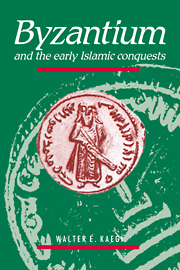Book contents
- Front Matter
- CONTENTS
- List of illustrations
- Preface
- List of abbreviations
- Chapter 1 The problem of Byzantium and the early Islamic conquests
- Chapter 2 The Byzantine Empire in an era of accelerating change
- Chapter 3 Difficulties in devising defenses for Syria
- Chapter 4 The first Muslim penetrations of Byzantine territory
- Chapter 5 Early tests in southern Palestine
- Chapter 6 Problems of cohesion: the battle of Jābiya- Yarmūk reconsidered
- Chapter 7 The brief struggle to save northern Syria and Byzantine Mesopotamia
- Chapter 8 Byzantium, Armenia, Armenians, and early Islamic conquests
- Chapter 9 Controversy and confidence in the seventh-century crisis
- Appendix 1 Author and date of the anti-jewish treatise
- Chapter 10 Elements of failure and endurance
- Bibliography
- Index
Chapter 2 - The Byzantine Empire in an era of accelerating change
Published online by Cambridge University Press: 22 September 2009
- Front Matter
- CONTENTS
- List of illustrations
- Preface
- List of abbreviations
- Chapter 1 The problem of Byzantium and the early Islamic conquests
- Chapter 2 The Byzantine Empire in an era of accelerating change
- Chapter 3 Difficulties in devising defenses for Syria
- Chapter 4 The first Muslim penetrations of Byzantine territory
- Chapter 5 Early tests in southern Palestine
- Chapter 6 Problems of cohesion: the battle of Jābiya- Yarmūk reconsidered
- Chapter 7 The brief struggle to save northern Syria and Byzantine Mesopotamia
- Chapter 8 Byzantium, Armenia, Armenians, and early Islamic conquests
- Chapter 9 Controversy and confidence in the seventh-century crisis
- Appendix 1 Author and date of the anti-jewish treatise
- Chapter 10 Elements of failure and endurance
- Bibliography
- Index
Summary
THE FINAL DECADES OF BYZANTINE AUTHORITY: AN OVERVIEW
All Christians praise and give glory and thanks to the One God, greatly rejoicing in His Name. For Chosroes, the haughty enemy of God, has fallen. He has fallen and tumbled into the depths, and his name has been obliterated from the earth. For the impious one who arrogantly and contemptuously spoke injustice against Our Lord Jesus Christ, The True God, and his unblemished Mother our blessed lady the Mother of God and ever Virgin Mary has perished resoundingly. His labor turned against him and his wrongfulness came down on his head.
Emperor Heraclius so announced to his subjects how the Byzantine Empire had finally triumphed over the Sassanian Empire and its monarch, Chosroes II Parviz, in 628 after approximately a quarter-century of intensive warfare that had devastated many provinces of both empires. Emperor Maurice's self-sworn avenger Heraclius had overthrown Phocas in 610, and assumed responsibility as emperor for the defense of the empire and the faith, and the expulsion of the Persians. Although the Persians had overrun Syria and Palestine and threatened to occupy all of Asia Minor and even approached Constantinople, it was Heraclius who, after reconstituting his armies, had brought the war to the heart of the Sassanian Empire in early 628. The overthrow and death of Chosroes ensued.
After imposing peace terms on Persia, essentially the territorial status quo ante, restoring the Byzantine borders of 590 at the Khābūr River, Heraclius, now about fifty-three years of age, returned to Constantinople.
- Type
- Chapter
- Information
- Byzantium and the Early Islamic Conquests , pp. 26 - 46Publisher: Cambridge University PressPrint publication year: 1992



